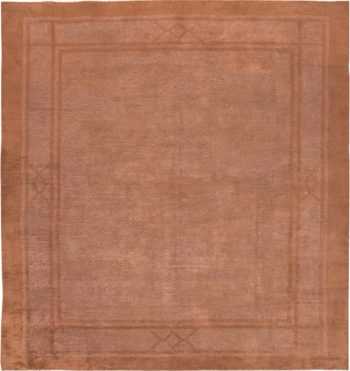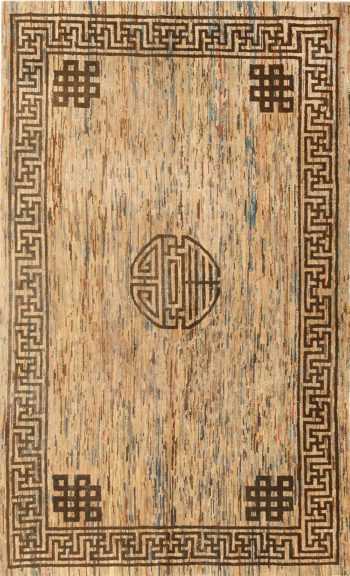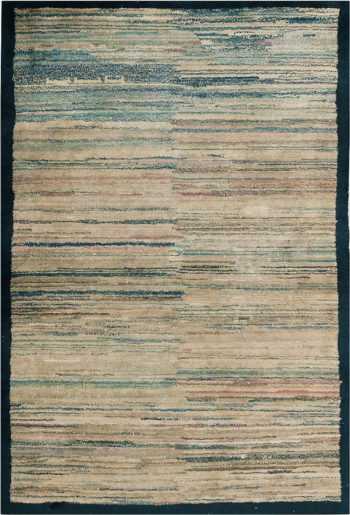Mongolian Rug Collection
Create Ambiance: Shop Our Collection Of Antique Mongolian Rugs
View our current antique selection of Mongolian rugs below:
Beautiful Earthtone Square Size Antique Mongolian Rug 44892
Size: 10 ft 6 in x 11 ft 3 in (3.2 m x 3.43 m)Antique Dragon Design Mongolian Rug 72319
$58,000.00Size: 10 ft 3 in x 11 ft (3.12 m x 3.35 m)Small Soft Color Neutral Simplistic Antique Mongolian Area Rug 2865
$6,600.00Size: 5 ft 3 in x 8 ft 9 in (1.6 m x 2.67 m)Rustic Small Antique Abstract Mongolian Rug 2919
$4,650.00Size: 3 ft 9 in x 5 ft 7 in (1.14 m x 1.7 m)
Learn More About Antique Mongolian Rugs
View Our Entire Collection of Antique Chinese Rugs
Mongolian Rugs have along history going back almost to the Mongol period in China. Few if any early antique carpets of this kind are actually are preserved, but they are represented in illuminated Chinese manuscripts, where they appear in a form similar to examples still produced today. Mongolian carpets have a transparent composition utilizing see-through motifs against a uniform ground, in keeping with antique Chinese rug design. The motifs themselves are generally Chinese – meanders, knot-work, and fretted medallions – with a taste for open spaces. Colors are soft and earthy with emphasis on subtle mixing of tones or variegation.
Unlike countries that developed their own motifs and style, Mongolian carpets are the product of outside influences particularly from China. Scholars believe the majority of Mongolian rugs were created by foreign minorities living in the area. On the Asian Steppe, highly decorative felt rugs and panels with undulating motifs were created, but these bear little similarity to the Chinese-influenced Mongolian rugs seen on the market today. Because the domestic carpet weaving industry is small compared to high-profile areas, antique Mongolian carpets are rare commodities.
Stylistically, antique Mongolian rugs feature a variety of Chinese patterns and Buddhist symbols that are drawn in a simplified manner. The color schemes are similarly restrained. Soft neutrals, somber earth tones, stately jewel tones and coral pink accents are found in Mongolian rugs. Weavers in Mongolia used more restricted color schemes than Chinese weavers, but they also used colors differently to produce decorative variegation and textural patterns. Many of these graphic rugs feature subtle variations on traditional eastern motifs.
In general, Mongolian rugs depict Chinese-influenced patterns, such as fretwork spandrels, endless knots, shou symbols, tigers and Buddhist motifs. They also have a preference for eastern design principles that use negative space effectively and incorporate a less-is-more style that works well in modern interiors.
What are Mongolian Rugs?
Mongolian rugs, also known as Mongolian carpets or Mongolian felt rugs, are traditional floor coverings made by the nomadic people of Mongolia. These rugs are crafted using a technique that involves felting, which is the process of matting and pressing fibers together to create a dense and durable fabric. The primary material used in Mongolian rugs is wool, often sourced from the sheep that the nomadic herders raise.
The making of Mongolian rugs involves several steps:
- Shearing: Wool is obtained by shearing the fleece from sheep. Mongolian sheep wool is known for its softness and warmth.
- Cleaning and Carding: The wool is then cleaned and carded to remove impurities and align the fibers in the same direction.
- Felting: The carded wool is arranged into a desired pattern or design, and then the felting process begins. This involves applying moisture and pressure to the wool fibers, causing them to mat and fuse together. The result is a dense and sturdy fabric.
- Design and Colors: Mongolian rugs often feature traditional nomadic designs, symbols, and patterns that reflect the cultural heritage of the Mongolian people. The colors used are typically earthy tones, reflecting the natural surroundings of the nomadic lifestyle.
- Finishing: Once the felting process is complete, the rug is trimmed, shaped, and finished to achieve the desired size and appearance.
Mongolian rugs are valued for their durability, insulation properties, and cultural significance. They are commonly used in traditional Mongolian yurts (ger), providing warmth and comfort in the harsh climate of the region. These rugs may also serve decorative purposes, displaying intricate patterns and designs that carry symbolic meanings within Mongolian culture.
What makes the Mongolian rugs, especially the older examples, so special?
Old Mongolian rugs are considered special and valuable for several reasons:
- Cultural Significance: Old Mongolian rugs often carry a rich cultural significance, reflecting the history, traditions, and symbols of the nomadic Mongolian people. The designs and patterns on these rugs may tell stories or convey specific meanings that are deeply rooted in the local culture.
- Handcrafted Artistry: Traditional Mongolian rugs are handmade by skilled artisans using ancient techniques passed down through generations. The craftsmanship involved in creating these rugs adds a level of artistry and uniqueness that distinguishes them from mass-produced items.
- Natural Materials: Old Mongolian rugs are typically crafted from natural materials, such as locally sourced wool from Mongolian sheep. The use of natural fibers enhances the rugs’ durability, insulation properties, and connection to the nomadic way of life.
- Time-Tested Techniques: The felting technique used in making Mongolian rugs is a time-tested method that has been perfected over centuries. The labor-intensive process of felting wool by hand contributes to the quality and longevity of these rugs.
- Patina and Aging: Like many handcrafted items, Mongolian rugs develop a unique patina over time. The natural wear and aging process can add character to the rug, making it more visually interesting and enhancing its vintage appeal.
- Limited Availability: Old Mongolian rugs are not mass-produced, and their production is often limited by the available skilled artisans and the time-consuming nature of the traditional crafting process. This scarcity can make them highly sought after by collectors and enthusiasts.
- Symbolism and Meaning: The symbols and patterns woven into old Mongolian rugs often carry specific meanings within Mongolian culture. These symbols can include representations of nature, animals, spirituality, and other elements significant to the nomadic way of life.
- Connection to Nomadic Lifestyle: Mongolian rugs are deeply connected to the nomadic lifestyle of the Mongolian people. They have been used for centuries in traditional yurts, providing both practical insulation and a form of artistic expression within the nomadic dwellings.
Overall, the combination of cultural heritage, craftsmanship, natural materials, and unique design elements contributes to the special and enduring appeal of old Mongolian rugs.




